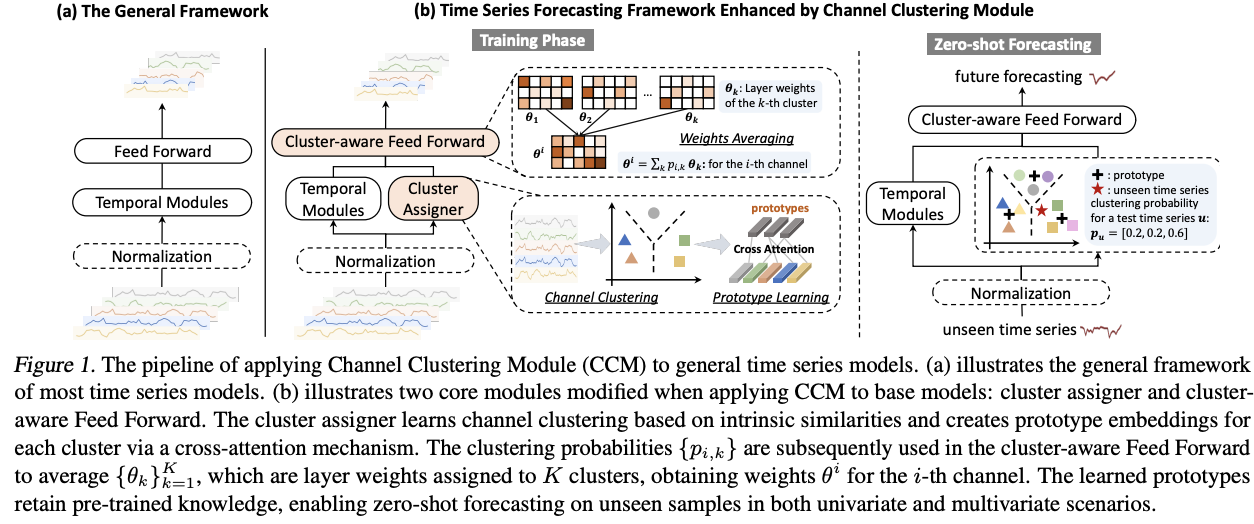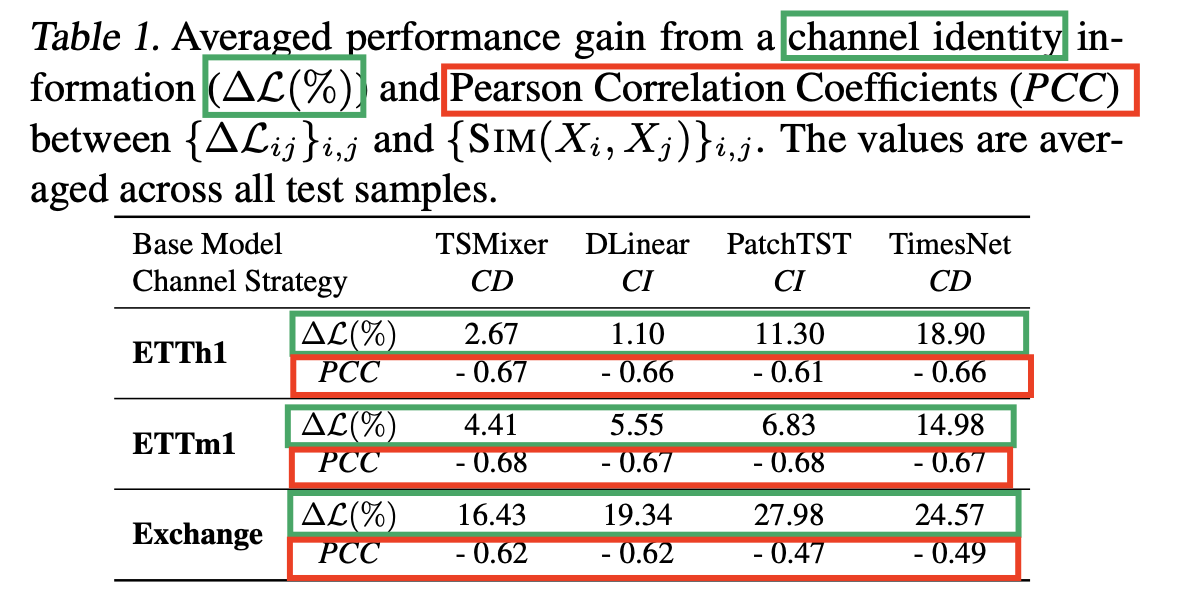From Similarity to Superiority: Channel Clustering for Time Series Forecasting
Contents
- Abstract
- Introduction
- Problem Definition
- Are Temporal Feature Extractors Effective?
- Theoretical and Empirical Study on the Linear Mapping
- Experiments
0. Abstract
CI
- Treat different channels individually
- Leads to poor generalization on unseen instances
- Ignores potentially necessary interactions between channels.
CD
- Mixes all channels with even irrelevant and indiscriminate information
- Results in oversmoothing issues
- Limits forecasting accuracy.
Background
- Lack of channel strategy that effectively balances individual channel treatment for improved forecasting performance without overlooking essential interactions between channels.
Motivation (Observation)
- Correlation between the TS model’s performance boost against channel mixing and the intrinsic similarity on a pair of channels
Proposal: Novel and adaptable Channel Clustering Module (CCM)
-
Dynamically groups channels characterized by intrinsic similarities
-
Leverages cluster identity ( instead of channel identity )
$\rightarrow$ Combining the best of CD and CI worlds
1. Introduction
Channel Clustering Module (CCM)
Simultaneously…
- (1) Balances individual channel treatment
- (2) Captures necessary cross-channel dependencies
Motivated by the following key observations
- (1) Both (CI & CD) heavily rely on channel identity information
- (2) Level of reliance is anti-correlated with the similarity between channels (Section 4.1)
$\rightarrow$ CCM thereby involves the strategic clustering of channels into cohesive clusters
-
Intra-cluster channels exhibit a higher degree of similarity, effectively replacing channel identity with cluster identity.
-
Cluster-aware FFN to ensure individual management of each cluster
-
Learns expressive prototype embeddings in the training phase,
$\rightarrow$ Enable zero-shot forecasting on unseen samples
( by grouping them into appropriate clusters )
Summary
- Plug-and-play solution
- 4 different time series backbones (aka. base models)
- TSMixer (Chen et al., 2023)
- DLinear (Zeng et al., 2022)
- PatchTST (Nie et al., 2022)
- TimesNet (Wu et al., 2022)
2. Related Works
(1) TSF models
pass
(2) Channel Strategies in TSF
CD strategy
- Most DL methods
- Aiming to harness the full spectrum of information across channels.
CI strategy
- Build forecasting models for each channel independently
Comparison (Han et al., 2023; Li et al., 2023a; Montero-Manso & Hyndman, 2021)
- CD = high capacity and low robustness,
- CI = opposite
PRReg (Han et al., 2023)
- Predicting residuals with regularization
- To incorporate a regularization term in the objective to encourage smoothness in future forecasting
$\rightarrow$ However, the essential challenge of channel strategies from the model design perspective has not been solved!
Remains challenging to develop a balanced channel strategy with both high capacity and robustness
[ Prior research ]
Effective clustering of channels to improve the predictive capabilities in diverse applications
- Image classification (Jiang et al., 2010)
- Natural language processing (NLP) (Marin et al., 2023; George & Sumathy, 2023)
- Anomaly detection (Li et al., 2012; Syarif et al., 2012; Gunupudi et al., 2017).
- ex) Traffic prediction (Ji et al., 2023; Liu et al., 2023a)
- Clustering techniques have been proposed to group related traffic regions to capture intricate spatial patterns.
- Still, the potential and effect of channel clustering in TSF remain under-explored.
3. Preliminaries
(1) Time Series Forecasting.
- $X=\left[x_1, \ldots \boldsymbol{x}_T\right] \in$ $\mathbb{R}^{T \times C}$
- $x_t \in \mathbb{R}^C$ .
- $Y=\left[\hat{\boldsymbol{x}}{T+1}, \ldots, \hat{\boldsymbol{x}}{T+H}\right] \in \mathbb{R}^{H \times C}$,
- $X_{[;, i]} \in \mathbb{R}^T$ ( $X_i$ for simplicity ) to denote the $i$-th channel in TS
(2) CI vs. CD
[CI] $f^{(i)}: \mathbb{R}^T \rightarrow \mathbb{R}^H$ for $i=1, \cdots, C$,
[CD] $f: \mathbb{R}^{T \times C} \rightarrow \mathbb{R}^{H \times C}$.
4. Proposed Method

Channel Clustering Module (CCM)
-
(1) Model-agnostic method
-
(2) General TS vs. General TS + CCM: Figure 1
- 3 components
- (1) (Optional) Normalization layer
- (e.g., RevIN (Kim et al., 2021), SAN (Liu et al., 2023c))
- (2) Temporal modules
- i.e.) Linear layers, transformer-based, or convolutional backbones,
- (3) Feed-forward layer
- forecasts the future values.
- (1) (Optional) Normalization layer
- 3 components
(1) Motivation for Channel Similarity
[ Toy experiment ]
Verify the following two assumptions
- (1) Existing forecasting methods heavily rely on channel identity information.
- (2) This reliance clearly anti-correlates with channel similarity: for channels with high similarity, channel identity information is less important.
$\rightarrow$ Motivate us to design an approach that provides cluster identity instead of channel identity
- Combining the best of both worlds: high capacity and generalizability
Backbones
- Linear models
- (1) TSMixer (Chen et al., 2023): CD
- (2) DLinear: CI
- Transformer-based model
- (3) PatchTST (Nie et al., 2022): CI
- CNN-based model
- (4) TimesNet (Wu et al., 2022): CD
Experimental setups
-
Train a TS model across all channels
-
Evaluate the channel-wise MSE on test set
-
Repeat training while randomly shuffling channels in each batch.
$\rightarrow$ This means channel identity information will be removed
Result: Average performance gain across all channels based on the random shuffling experiments

Summary
- (1) All models rely on channel identity information
- (2) This performance gap anti-correlates with channel similarity
(2) CCM: Channel Clustering Module
a) Channel Clustering
Procedure
-
(1) Initialize a set of $K$ cluster embedding $\left{c_1, \cdots, c_K\right}$,
- where $c_k \in \mathbb{R}^d$
-
(2) Each channel $X_i$ is transformed into channel embedding $h_i$ through an MLP
-
(3) Probaiblity
-
Prob ( Channel $X_i$ is associated with the $k$-th cluster )
= Normalized inner-product of the cluster embedding $c_k$ and the channel embedding $h_i$
-
$p_{i, k}=\operatorname{Normalize}\left(\frac{c_k^{\top} h_i}{\left|c_k\right|\left|h_i\right|}\right) \in[0,1]$.
-
Reparameterization trick (Jang et al., 2016)
- To obtain the clustering membership matrix $\mathbf{M} \in \mathbb{R}^{C \times K}$ ,
- where $\mathbf{M}{i k} \approx \operatorname{Bernoulli}\left(p{i, k}\right)$.
b) Prototype Learning
Cluster assigner
-
Also creates a $d$-dimensional prototype embedding ( for each cluster )
- $\mathbf{C}=\left[c_1, \cdots, c_K\right] \in \mathbb{R}^{K \times d}$: cluster embedding
- $\mathbf{H}=\left[h_1, \cdots, h_C\right] \in \mathbb{R}^{C \times d}$: hidden embedding of the channels
Modified cross-attention
$\widehat{\mathbf{C}}=\text { Normalize }\left(\exp \left(\frac{\left(W_Q \mathbf{C}\right)\left(W_K \mathbf{H}\right)^{\top}}{\sqrt{d}}\right) \odot \mathbf{M}^{\top}\right) W_V \mathbf{H}$.
- where the clustering membership matrix $\mathbf{M}$ is an approximately binary matrix to enable sparse attention on intra-cluster channels specifically
Prototype embedding $\widehat{\mathbf{C}} \in \mathbb{R}^{K \times d}$
- Serves as the updated cluster embedding for subsequent clustering probability
c) Cluster Loss
Further introduce a specifically designed loss function for the clustering quality
Cluster Loss: Incorporates both the
- (1) Alignment of channels with their respective clusters
- (2) Distinctness between different clusters in SSL
Notation
- $\mathbf{S} \in \mathbb{R}^{C \times C}$: Channel similarity matrix
- with $\mathbf{S}_{i j}=\operatorname{Sim}\left(X_i, X_j\right)$
- ClusterLoss: $\mathcal{L}_C=-\operatorname{Tr}\left(\mathbf{M}^{\top} \mathbf{S M}\right)+\operatorname{Tr}\left(\left(\mathbf{I}-\mathbf{M} \mathbf{M}^{\top}\right) \mathbf{S}\right)$$
- $\operatorname{Tr}\left(\mathbf{M}^{\top} \mathbf{S M}\right)$ : maximizes the channel similarities within cluster
- $\operatorname{Tr}\left(\left(\mathbf{I}-\mathbf{M} \mathbf{M}^{\top}\right) \mathbf{S}\right)$: encourages separation between clusters
Final loss function
- $\mathcal{L}=\mathcal{L}_F+\beta \mathcal{L}_C$,
d) Cluster-aware Feed Forward
CI vs CD vs CCM
-
CI: Individual Feed Forward per channel
-
CD: Shared Feed Forward per channel
-
CCM: Cluster-aware Feed Forward
- Use cluster identity to replace channel identity
Notation
- $h_{\theta_k}(\cdot)$ : the linear layer for the $k$-th cluster
- $Z_i$ : the hidden embedding of the $i$-th channel ( before the last layer )
Final forecast
- Averaged across the outputs of all cluster-aware FFN
- with $\left{p_{i, k}\right}$ as weights
- $Y_i=\sum_k p_{i, k} h_{\theta_k}\left(Z_i\right)$ for the $i$-th channel.
( For computational efficiency, it is equivalent to $Y_i=h_{\theta^i}\left(Z_i\right)$ with averaged weights $\theta^i=\sum_k p_{i, k} \theta_k$. )
